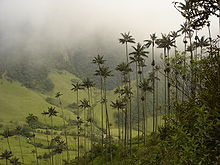- National symbols of Colombia
-
The flag of Colombia in Cartagena, Colombia.

The National symbols of Colombia are the symbols which represent the national identity of the Republic of Colombia as a sovereign state. The national symbols intend to represent the Colombian identity by creating visual, verbal cultural iconic representations of the national people, values, goals, and history.
These symbols are often rallied around as part of celebrations of patriotism and are designed to be inclusive and representative of all the peoples of the national community.
Contents
National Flag of Colombia
Main article: Flag of ColombiaThe Colombian flag was defined in 1934 by the Decrees 861 of 1934, expedited by the Government of Colombia during the presidencies of General Pedro Nel Ospina and Enrique Olaya Herrera.
As defined in the Constitution of Colombia Decree number 861 of May 17, 1934 in Article 1, the pavilion, flag and standard of the Republic of Colombia is composed by the yellow, blue and red colors distributed in three horizontal stripes. The yellow top stripe is positioned in the upper area of the flag and has a width of half of the entire flag horizontally. The other two stripes the middle blue and the bottom red will each be a fourth of the total area of the flag. The yellow color represents Colombia's gold and natural wealthiness; the blue color represents the two oceans that border Colombia, the Pacific and Atlantic oceans, rivers and the sky; The red color represents the blood of the patriots that fought against the Spanish monarchy to gain the independence of Colombia. Authorized variations of the Colombian flag also represent the merchant flag of Colombia, the War flag of Colombia exclusively used by the Colombian Army. The flag with the Colombian coat of arms is of exclusive use of the armed institutions of Colombia.[1]
Coat of arms of Colombia
Main article: Coat of arms of ColombiaThe coat of arms of Colombia is considered the symbols of all symbols in Colombia. The coat of arms integrates the major symbols for which the Colombian identity prevails. It was updated by Protocol based in Decree 1967 of 1991 as stated in the Colombian Constitution of 1991. The coat of arms of Colombia is only used in the center of the flag of the President of Colombia, war flag of Colombia and official documents. It can also be used for educational or display purposes within the guidelines of respect for the symbol.
Four flags
The shield is posing over four flags of Colombia diverging from the base in which the two upper ones form an angle of 90º degrees and separated from the bottom ones 15º degrees. These flags are posted towards the coat of arms' vertex.
National Tree of Colombia
The Wax palm tree Ceroxylon quindiuense, is a palm native to the Andean high altitude Cocora valley in the department of Quindío, northwest Colombia.
National flower of Colombia
 Cattleya trianae is the national flower of Colombia.
Cattleya trianae is the national flower of Colombia. See also: Cattleya trianae
See also: Cattleya trianaeThe national flower of Colombia is the orchid Cattleya trianae which was named after the Colombian naturalist José Jerónimo Triana. The orchid was selected by botanist Emilio Robledo, in representation of the Colombian Academy of History to determine the most representative flowering plant of Colombia. He described it as one of the most beautiful flowers in the world and selected Cattleya trianae as National symbol.
-
Colombian coffee has a Protected Designation of Origin
-
The largest Emerald in the world (Gachala Emerald). Colombian emeralds have the highest quality worldwide
-
Colombia is the main producer and exporter of roses worldwide
-
Paso Fino Horse is the national horse breed
-
Colombia has the largest amount of amphibian species in the world. In the photo the most poisonous vertebrate ever Phyllobates terribilis
-
Colombia has the largest amount of heliconia species worldwide
-
Tejo is the national sport
References
 National symbols of Colombia
National symbols of ColombiaNational symbols of South America Sovereign states - Argentina
- Bolivia
- Brazil
- Chile
- Colombia
- Ecuador
- Guyana
- Panama
- Paraguay
- Peru
- Suriname
- Trinidad and Tobago
- Uruguay
- Venezuela
Categories: -
Wikimedia Foundation. 2010.











